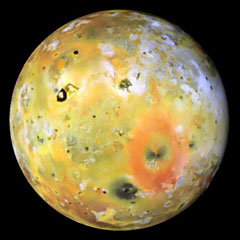Ío es una luna de Júpiter, perteneciente a las cuatro lunas galileanas (Ío, Calisto, Europa y Ganímedes), descubiertas por Galileo en 1610. Se sitúa a unos 420000 km de la superficie de Júpiter, siendo el satélite más cercano de los galileanos en orbitar frente a Júpiter; tarda un día y 18 horas en girar alrededor de él y sobre sí mismo, con lo que siempre está mostrando su misma cara a Júpiter, al igual que ocurre con la Luna terrestre y la temperatura en su superficie es de unos -140 ºC. Es una luna muy conocida por su extrema actividad volcánica, causada por una fuerte interacción gravitatoria de esta con Júpiter, como las mareas aquí, con una atmósfera formada por dióxido de azufre (SO2) y por sublimación del hielo en gas.
Pero una de las principales peculiaridades que tiene Ío y que está relacionado con un descubrimiento que se acaba de realizar sobre él es que en cada rotación alrededor de Júpiter, este se coloca entre Ío y el Sol, habiendo un eclipse lunar en el que Ío queda totalmente bajo la sombra de Júpiter. Ahora, investigadores del Consejo Superior de Investigaciones Científicas y Tecnológicas de España, CSIC, ha descubierto que durante dichos eclipses, la atmósfera de Ío desaparece y vuelve a aparecer una vez que el eclipse ha pasado.
El equipo todavía desconoce las causas de este comportamiento, por lo que ciertas hipótesis se han propuesto: la actividad volcánica o el súbito cambio de temperaturas que sufre Ío durante el eclipse, con una amplitud térmica de hasta 30 grados (entre los -140ºC y los -170ºC), lo que podría facilitar la sublimación regresiva del dióxido de azufre, que se depositaría sobre la superficie, volviendo a sublimar tras estar expuesto de nuevo a la luz solar.
Lo impactante del descubrimiento es que Ío puede llegar a perder hasta el 80% de su atmósfera. El ciclo que experimenta la luna puede variar bastante, ya que se ve influido por su actividad volcánica, lo que llega a demostrar que no todos los gases de la atmósfera de Ío provienen de sus volcanes, sino que hay ciertos gases formados por la sublimación de los hielos de su superficie.
Io is a moon of Jupiter, belonging to the four galilean moons (Io, Callisto, Europa and Ganymede) discovered by Galileo in 1610. It is located 420000 km away from the surface of Jupiter, being the closest galilean moon to the surface of Jupiter; it spends a day and 18 hours in rotating around it and around itself, in such a way that it always the same face to Jupiter, as happens with the Moon and the Earth, and its temeperature is about -140ºC in its surface. It is a very known moon for its extreme volcanic activity, caused by a very strong gravitational interaction with Jupiter, as happens here with tides, with an atmosphere formed by sulphur dioxide (SO2) and by the sublimation of ice in gas.
But one of the most interesting facts happening in Io, which is related with a discovery done recently, is that it experiments a moon eclipse in each rotation cycle it does, in other words, Jupiter is between Io and the Sun, so Io is under the shadow of Jupiter. Now, researchers from the Upper Council of Scientific and Technological Research of Spain (CSIC, for its initials in Spanish), has discovered that during those eclipses, the atmosphere of Io disappears and reappears once the eclipse has happened.
The team does not know yet the causes of this behaviour, so some hypothesis have been proposed: the volcanic activity or the strong change in temperature during the eclipse, with an amplitude of more than 30ºC (-140 to -170ºC), what could favor the regressive sublimation of sulphur dioxide, that would deposit in the surface, sublimating again after being exposed to the sunlight.
What has been really impacting is that Io can lose a 80% of its atmosphere. The cycle that the moon experiences can change drastically, being influenced by the volcanic activity, what can prove that not all the gases of Io's atmosphere come from its volcanoes, but some gases are formed due to the sublimation of the ice in its surface.
Para más información / For more information: http://www.rtve.es/noticias/20160802/captan-colapso-atmosfera-io-durante-eclipse-jupiter/1380362.shtml

No hay comentarios:
Publicar un comentario